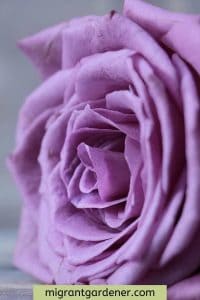What Do Roses Smell Like?

What Do Roses Smell Like?
Among the most favored of flowers in the U.S., the U.K., Australia, Canada, and elsewhere, roses produce what to many is arguably the most gorgeous-looking flower.
However, perhaps it’s the aroma that is most associated with roses. If you take a stroll through a rose garden of any size on a beautiful summertime morning and you’ll be amazed at the sheer range of scents. The scents can be nothing short of intoxicating!
Then, in the evening of the same day, take a further stroll and that range of aromas will be quite different. That’s because of the variety of chemicals involved in producing the scents.
What do roses smell like? What is it that causes the scent?
What do Roses Smell Like – Fragrant Compounds
Rose scents come in a myriad of ‘flavors’. Arguably, the most fragrant of roses is the Damask. Interestingly, the Damask is among the oldest of rose varieties.
Among the scent categories we get apple clove, lemon, and violets.
There are, though, more than 300 different chemicals which are known about and that are emitted by roses – those are the ones we know about. There are subtle difference between them.
There are some roses, many of which were bred back in the 19th century, that fail to have any scent. This is because back then the aroma was far less important than the visual display.
Over the previous 70-80 years or thereabouts, roses have been bred to be more fragrant. The odor of roses of definitely much more of a key component than it was in the 19th century.
Different Smell — Same Rose
Over the lifetime of one single rose flower, and even throughout a single day, the scent of one rose can alter. And why?
It’s because the rose is attempting to attract a variety of pollinators. And that, too, is the key reason for roses to release chemicals into the air.
Whenever a rose is ripe for pollination it will be releasing most of its scent.
Further, different compounds evaporate at different rates. So this means that we smell different scents from roses at different times of the day.
What Does a Rose Smell Like – Capturing the Scent of a Rose Using Chromatography
How would we know which compounds are captured inside a rose petal? We can turn to chromatography.
If we dry rose petals and then extract volatiles by way of HS-SPME (headspace-solid phase microextraction), analysis can then be done care of gas chromatography.
It’s likely that through analysis some several hundred various compounds will be found and these compounds can be categorised into a handful of main groups: hydrocarbons, alcohols, esters, ketones.
Classic rose oils that are utilized for manufacturing fragrances, those typically consist of a small amount of compounds as a way of carrying the scent.
The compounds are inclusive of rose ketone (β-damascenone) and cis-rose oxide. However, in order to produce a single kilogram (2.2 lbs.) of rose oil, it calls for more than 10 tonnes (2,204 lbs.) of rose petals. This is why the vast majority of rose frangrances are manufactured using synthetic oils.
So, when you’re next walking by some roses, be that in your garden or elsewhere, just take a moment to marvel at how it’s possible for Mother Nature to use more than 300 compounds as a way of pollinating a single rose.
Image by S. Hermann & F. Richter from Pixabay

